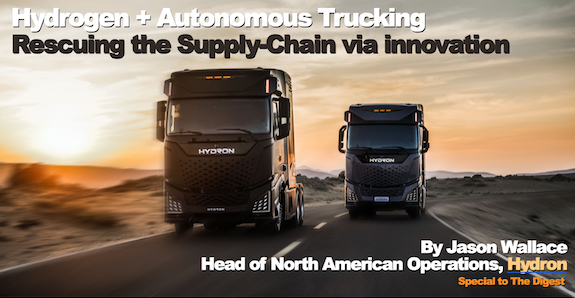How Hydrogen Propulsion Paired with Autonomous Trucking Can Drastically Improve the Supply Chain

By Jason Wallace, Head of North American Operations for Hydron, special to The Digest
While we can thank the trucking industry for the packages that arrive at our doors in what seems like mere minutes after we’ve ordered them, there is no denying that long-haul freight transportation still faces many challenges.
Today, the logistics industry faces a critical awakening while it searches for ways to minimize the environmental impact of trucking. While navigating greater scrutiny, fleet owners are still working to improve their bottom line by exploring ways to increase capacity, minimize unnecessary costs, and meet ambitious emissions regulations – all while tackling the uphill battle of global supply chain woes that aren’t going away anytime soon.

Jason Wallace, Head of North American Operations for Hydron
As fleet owners navigate these and other challenges, hydrogen propulsion paired with SAE L4 autonomous driving technology is emerging as a key solution to address each of these concerns.
Navigating the shortage of truck drivers
Driver shortages are at an all-time high, even though consumer demand for international products continues to rise. There are not enough qualified drivers to support the growth and insatiable demand for global goods. The worldwide Covid pandemic exacerbated these issues, increasing demand for door-to-door shipping. According to the American Trucking Association, the industry could be short of more than 160,000 drivers nationally by 2028.
At the same time, drivers have “hours-of-service” limitations that cap how much driving they can perform in one day safely. While the trucking industry continues to gain momentum, the lack of drivers has hindered growth.
Amid the shortage of workers, autonomous trucks can offer a promising way to bridge the gap. When combined with the fact that they can operate nearly continuously, stopping only for refueling and preventative maintenance, they are a solution that can help the industry win in more ways than one.
Ditching diesel
Trucking has always been associated with high carbon emissions rates and smogged air quality in return for convenience: fresh goods delivered to our local stores daily and our internet packages on our doorstep within two days of order placement. In fact, the U.S. Energy Information Administration (EIA) estimates that in 2020, diesel (distillate) fuel consumption in the U.S. transportation sector resulted in the emission of about 432 million metric tons of carbon dioxide (CO2), a greenhouse gas. This amount was equal to about 26% of total U.S. transportation sector CO2 emissions.
But diesel impacts more than the environment; it’s also subject to unpredictable pricing, which affects nearly every product we purchase. In the last year alone, we have seen price increases across the board, from groceries to furniture and everyday services. The national average price for diesel increased by 75%, translating to higher prices on store shelves.
You’ve probably noticed the price of food-at-home has increased between 8.5 and 9.5 percent in the last year, and food-away-from-home prices are up between 6 and 7 percent and – yes, we can fault diesel for that as the cost-per-gallon is now baked into those prices. All the above have contributed to rising inflation, which will continue to impact every aspect of the service chain.
The industry needs a more reliable and cost-effective way to power up. While many OEMs are considering battery power to minimize emissions, hydrogen is emerging as a serious contender to address these challenges.
EV vs. FCEV
One hundred percent battery electric has not won the race yet; while all eyes are on batteries, hydrogen is poised to shake up long-haul trucking and offers several advantages over battery electric. The more the industry looks at hydrogen fuel-cell solutions, the more apparent the benefits.
In addition to offering greater energy storage density than lithium-ion batteries alone, hydrogen provides a significant range advantage for electric vehicles. As we continue to navigate the unsteady supply chain, hydrogen is very quick to refuel, often in 20 minutes or less, which helps keep trucks on the road, improving overall capacity. While battery-powered vehicles are subject to long charging times and range anxiety, these are of no concern for hydrogen.
Given that 80 percent of freight travels along 20 percent of the nation’s highways, if we can automate these highways with shipping lanes and apply the necessary refueling infrastructure, hydrogen becomes an ideal fuel source for trucks continuously operating back and forth transporting our goods across the country.
Rapid progress has been made in the area of autonomous trucking in the last several years
In late 2021, one manufacturer touted its achievement of a fully automated lane and the ability to haul freight without a driver or safety driver in the truck’s cab. With the number of trucking and AI-based technology companies expeditiously working toward the same achievement, we can expect to see more trucks delivering goods without a driver on the road.
Electric trucks may be a smart choice for first and last-mile operations, but hydrogen-powered autonomous trucks provide greater benefits for long-haul and middle-mile transport. Of course, refueling infrastructure will need time to mature; when these advancements are in place, companies will want to take advantage of the financial benefits immediately.
Advancements in fuel-cell technology are now solvent and autonomy has been achieved, however, coupling autonomy with clean hydrogen power can address bottom line improvements, increased capacity, and emissions reductions. Implementation might be a few years off, especially when it comes to building out reliable refueling networks; but, the time to start building those networks is now.
What’s next for hydrogen-powered autonomous trucking?
One thing is for sure: it’s an exciting time for the future of mobility. We expect to see hydrogen-powered autonomous-ready trucks delivered to transport companies and large commercial fleets over the next several years.
By deploying hydrogen fueling stations along high-volume freight routes, we will be able to focus on high-volume locations, then scale based on demand. For example, The Texas triangle connecting Dallas, Houston, and San Antonio is a prime example of geographies that would benefit from hydrogen refueling infrastructure, and we see others across the map. And given that a majority of freight travels on only about a quarter of the nation’s highways, the most advantageous roads to build a hydrogen refueling network are laid bare.
Our company has decided to focus on developing trucks capable of autonomous operations while powered by a clean propulsion system and work with partners to build a robust fueling network to ensure continued momentum and benefit to the overall sector.
The future of trucking, redefined
While battery and fuel-cell technologies will continue to coexist, and autonomous technology will be applied to both, their niches will become more evident. Battery-powered vehicles will continue to be ideal for shorter distances, while hydrogen fuel cell offers more significant benefits for long-haul applications. However, the greatest overall benefit is expected from the combination of hydrogen and autonomous technology.
Merging autonomous technology with clean hydrogen power can help fleets meet the challenges we laid out earlier; support climate goals, keep goods moving 24 hours a day, lower costs and ultimately improve overall supply chain logistics (so we can start feeling slightly less guilty for our home delivery purchases).
Category: Top Stories















